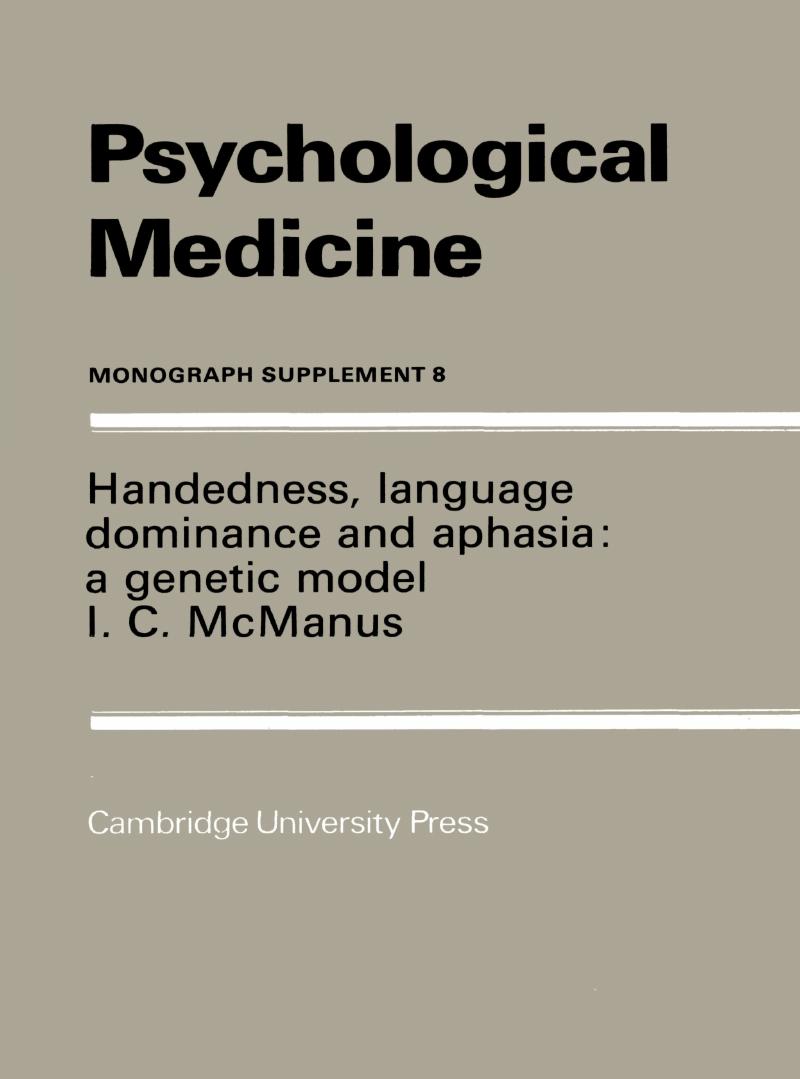Crossref Citations
This article has been cited by the following publications. This list is generated based on data provided by Crossref.
Crow, T. J.
1988.
Sex Chromosomes and Psychosis.
British Journal of Psychiatry,
Vol. 153,
Issue. 5,
p.
675.
Crow, T. J.
1990.
The Continuum of Psychosis and Its Genetic Origins.
British Journal of Psychiatry,
Vol. 156,
Issue. 6,
p.
788.
Annett, Marian
1991.
Annotation: Laterality and Cerebral Dominance.
Journal of Child Psychology and Psychiatry,
Vol. 32,
Issue. 2,
p.
219.
Nowakowski, Richard S.
1992.
Neurodevelopment, Aging and Cognition.
p.
99.
McManus, I.C.
and
Bryden, M.P.
1992.
Handedness of parents and sex of progeny: Failure to replicate the results of James (1986).
Journal of Theoretical Biology,
Vol. 159,
Issue. 4,
p.
439.
1992.
Psychology in Medicine.
p.
309.
McManus, I. C.
1992.
Are paw preference differences in HI and LO mice the result of specific genes or of heterosis and fluctuating asymmetry?.
Behavior Genetics,
Vol. 22,
Issue. 4,
p.
435.
Henninger, Polly
1992.
Handbook of Neuropsychological Assessment.
p.
141.
Collins, Robert L.
Sargent, Evelyn E.
and
Neumann, Paul E.
1993.
Genetic and behavioral tests of the McManus hypothesis relating response to selection for lateralization of handedness in mice to degree of heterozygosity.
Behavior Genetics,
Vol. 23,
Issue. 4,
p.
413.
Reiβ, Michael
1994.
Leg-crossing: Incidence and inheritance.
Neuropsychologia,
Vol. 32,
Issue. 6,
p.
747.
Biederman, Joseph
Milberger, Sharon
Faraone, Stephen V.
Lapey, Kathleen A.
Reed, Ellen D.
and
Seidman, Larry J.
1995.
No confirmation of Geschwind's hypothesis of associations between reading disability, immune disorders, and motor preference in ADHD.
Journal of Abnormal Child Psychology,
Vol. 23,
Issue. 5,
p.
545.
Porac, Clare
1995.
Genetic vs. environmental contributions to human handedness: Insights gained from studying individuals with unilateral hand injuries.
Behavior Genetics,
Vol. 25,
Issue. 5,
p.
447.
Curt, Florence
De Agostini, Maria
Maccario, Jean
and
Dellatolas, Georges
1995.
Parental hand preference and manual functional asymmetry in preschool children.
Behavior Genetics,
Vol. 25,
Issue. 6,
p.
525.
Annett, Marian
Eglinton, Elizabeth
and
Smythe, Pamela
1996.
Types of Dyslexia and the Shift to Dextrality.
Journal of Child Psychology and Psychiatry,
Vol. 37,
Issue. 2,
p.
167.
Annett, Marian
and
Alexander, Michael P.
1996.
Atypical cerebral dominance: Predictions and tests of the right shift theory.
Neuropsychologia,
Vol. 34,
Issue. 12,
p.
1215.
Corballis, M. C.
Lee, K.
McManus, I. C.
and
Crow, T. J.
1996.
Location of the handedness gene on the X and Y chromosomes.
American Journal of Medical Genetics,
Vol. 67,
Issue. 1,
p.
50.
ANNETT, MARIAN
1996.
Laterality and Types of Dyslexia.
Neuroscience & Biobehavioral Reviews,
Vol. 20,
Issue. 4,
p.
631.
Curt, F.
Mesbah, M.
Lellouch, J.
and
Dellatolas, G.
1997.
Handedness Scale: How Many and Which Items?.
Laterality: Asymmetries of Body, Brain and Cognition,
Vol. 2,
Issue. 2,
p.
137.
Annett, Marian
1997.
Schizophrenia and Autism Considered as the Products of an Agnosic Right Shift Gene.
Cognitive Neuropsychiatry,
Vol. 2,
Issue. 3,
p.
195.
Crow, Timothy J.
1997.
Is schizophrenia the price that Homo sapiens pays for language?.
Schizophrenia Research,
Vol. 28,
Issue. 2-3,
p.
127.





